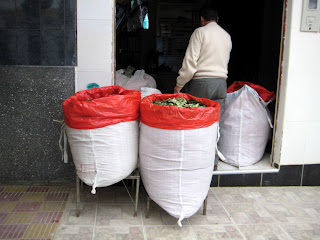Since we crossed the
border into Bolivia, we haven’t seen a single person drinking mate. It turns
out that here, the social common ground of choice is the coca leaf.
In La Paz we paid a
visit to the Coca Museum, which documents the spiritual and social role that
the coca plant plays in the Bolivian, Argentine, Chilean and Columbian
cultures. Through cave drawings and other artifacts, it’s easy to see that coca
leaves have been chewed in this area for thousands of years. The leaves have
nutritional properties that help suppress hunger, keep the mind alert, and
stave off altitude sickness. During the mining era, coca leaves were the only
way that the miners – who were subjected to 48-hour workdays – survived.
As we were getting
off our bus from Uyuni to La Paz, we found a trail of coca leaves that the bus
driver had left behind. Hey, whatever keeps him alert is fine by us.
It wasn’t until the
1800s that a doctor from France extracted one of the alkaloids in the coca leaf
and refined it into cocaine. The museum had an interesting timeline that showed
how American doctors led the use of cocaine as anesthetic for surgeries.
The museum also
demonstrated how makeshift and remote the illegal cocaine refinery shacks are.
Without help from Americans who have the knowledge and chemicals to refine the
leaves into cocaine, these simple farmers would never be able to do it on their
own. In a way, we felt sorry for the countries where the coca leaf is a
cultural staple. Developed countries, led by the US, have taken something legal
and sacred to them and turned it into a demon.
What we’ve learned
from Bolivia is that, unless you’re dealing with the bad guys doing illegal
stuff in the remote jungles, coca leaves are nothing to be ashamed of. They can
be found and bought from large bins on the street curb of almost any
convenience store. A huge bag of leaves might cost $1.
On our bike ride down
The Death Road, farmers were drying their coca leaves right on the road and we could see coca plantations on the hillsides.
The leaves are
commonly placed in hot water to make a delicious tea. You can find coca-flavored
cookies and ice cream. The leaves are placed in baskets at breakfast buffets.
Even the Coca-Cola Company purchases coca leaves every year to help flavor your
soft drinks.
So the next time you
drink a Diet Coke, think for a second about the legal Bolivian farmers and the
culture they’re trying to preserve.




No comments:
Post a Comment